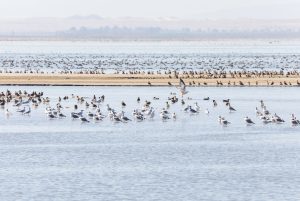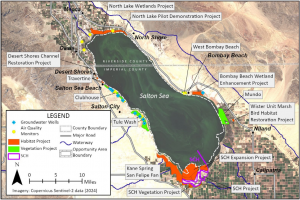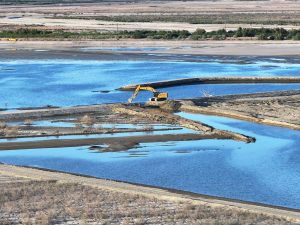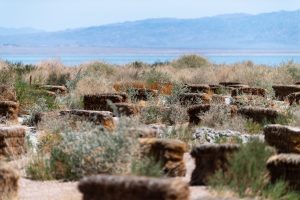Project Delivery
California’s Salton Sea Management Program 10-Year Plan

Different species of birds are seen near the Species Conservation Habitat Project Expansion area at the Salton Sea.
Aided by input from community members, local leaders, and interested groups, California state agencies are focused on implementing projects as part of the Salton Sea Management Program’s 10-year plan. The plan calls for the construction of habitat restoration and dust suppression on 29,800 acres of exposed lakebed and areas that will be exposed by 2028.
Since the state is not a significant landowner around the Salton Sea, collaboration with various land-owning entities is critical to the SSMP team’s ability to implement projects. Land-access agreements and permits must be secured before soil testing or construction work begins. As a result, the SSMP is prioritizing work to secure land access in areas with the highest emissivity potential. These projects will help control dust and limit Sea-related impacts on air quality for communities such as Salton City, Bombay Beach, and North Shore. Currently, there are multiple locations around the Sea with active construction and shovels on the ground.

Projects in progress and potential future projects under consideration at the Salton Sea. The Opportunity Area boundary indicates the portion of the Sea covered by the NEPA EA for the Phase 1: 10-Year Plan
Salton Sea Monitoring Implementation Plan
Developed in collaboration with the SSMP Science Committee, the Monitoring Implementation Plan (MIP) is a regional-scale monitoring plan for the Salton Sea ecosystem. It describes monitoring activities to measure conditions of water, air quality, land cover, biological resources, and socioeconomics. The MIP provides a framework for future project-scale monitoring plans and identifies and prioritizes filling of existing data gaps. It also promotes practices to best store, manage, and make monitoring data publicly available in a timely manner.
Salton Sea Monitoring Implementation Plan
Plan de Implementación de Monitoreo de Salton Sea
Dust Suppresion Action Plan
The Dust Suppression Action Plan will serve as a “living document” that will be refined over time through continued community collaboration with local air pollution control districts, landowners, and other stakeholders. Future dust suppression activities will also be informed by monitoring and adaptive management of completed projects.
Learn more details in the Dust Suppression Action Plan
Species Conservation Habitat Project
The Species Conservation Habitat (SCH) Project is the state’s first large-scale project to reduce exposed lakebed and create environmental habitat. Following initial onsite work in 2020, the state’s design-build contractors, Kiewit Infrastructure West Co., began construction in 2021 on the $206.5 million project located at the southern end of the Salton Sea on both sides of the New River.

Picture taken on April 2. Looking east of the New River Diversion Structure, a berm was breached to allow water to flow by gravity from the east sedimentation basin into the east pond.
The SCH, enabled by land access and water use agreements with the Imperial Irrigation District, will create a network of ponds with islands and areas of varying water depths to provide important fish and bird habitat and suppress dust emissions to improve regional air quality as the Salton Sea recedes.
Previously envisioned as a 4,100-acre project funded primarily through the State’s bond funds at a cost of approximately $206.5 million, the State secured commitments from the federal government in 2023, 2024, and 2025 totaling $245 million in additional funding, which will allow the Species Conservation Habitat Project to more than double in size.
The total Species Conservation Habitat Project footprint is now envisioned to span over 9,000 acres – enough space to fit roughly 7,500 football fields. It will create a network of ponds, berms, nesting and loafing islands, and water delivery systems engineered to sustain fish and bird populations — restoring ecosystem function and protecting air quality by reducing dust at a key area of previously exposed lakebed at the Salton Sea. The filling of the East Pond Expansion, combined with the filling of the original East Pond in early April, means that roughly 2,000 acres of the project will be operational in the coming weeks. Additional work continues to complete the remaining expansion components of the project.
Air Quality Monitoring Report at the SCH site
The state team is focused on implementing near-term dust control projects and has developed a Dust Suppression Action Plan (DSAP) to prioritize and identify approximately 9,800 acres of planning areas for dust suppression projects on emissive lakebed at locations around the Salton Sea. About 755 acres of temporary dust suppression projects were completed in 2020. These acres are a first step with further plans to include water and develop habitat for fish and birds. The Bruchard Road Dust Suppression Project was the first project completed. The 112-acre project, located near the mouth of the New River, was designed to reduce fugitive dust emission from areas of lakebed that have been exposed due to dropping lake levels. The project also served to develop a streamlined permitting approach that can be implemented at other sites to expedite projects around the Salton Sea. Two other dust suppression projects were completed in 2020. The project concept in the Dust Suppression Action Plan included Phase A projects that comprise waterless techniques to suppress dust to be implemented first, and Phase B projects that typically use water and will provide both dust suppression and habitat values for the life of the program.

Planted Native vegetation growing between rows of grass bales at a Vegetation Enhancement Project site on the exposed Salton Sea lakebed near Salton City.
The SSMP Team obtained site access from the U.S. Bureau of Reclamation in 2020 to develop dust suppression projects as a high priority. Three sites with significant Reclamation-owned land: Clubhouse, Tule Wash, and West Bombay Beach are now being prioritized. The Clubhouse and Tule Wash sites were identified in the DSAP as high-priority sites for dust suppression because of their emissivity potential and proximity to communities. The West Bombay Beach site was added due to its emissivity potential and proximity to the community of Bombay Beach
The goal of vegetation enhancement projects is to suppress dust from exposed lakebed areas around the Salton Sea through native vegetation establishment, enhancement of existing vegetation stands, and stabilization of the lakebed through physical means to allow seed germination and plant growth (collectively referred to as “vegetation enhancement”). These projects have been prioritized for emissive areas of the exposed lakebed where surface water supplies are extremely limited and other forms of aquatic habitat creation (such as ponds or wetlands) are generally not possible.

